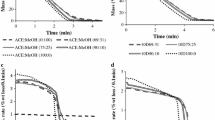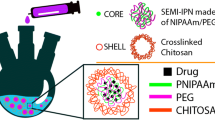Abstract
Polymer chain entanglements in organic solvents can be considered a key parameter in the formation of non-spherical beads when electrospraying is employed. The shape of micro/nanometric drug delivery systems plays a major role since it can affect circulation, extravasation, distribution and in vivo clearance of the devices. In this frame, we investigated the influence of polymer processing parameters on the design of polylactic-co-glycolic acid non-spherical microdevices loaded with triamcinolone acetonide (TrA), a sparingly water soluble corticosteroid, prepared by electrospraying technique through a one-step process. In particular, we verified that the formation of non-spherical MDs is related to the presence of entanglements among polymer chains to select the optimal solution to be sprayed. The addition of TrA did not substantially affect the particle morphology in terms of size, size distribution and circularity at all the tested drug loadings. Furthermore, the drug could be released for a prolonged period, with controlled and reproducible kinetics for over 3 weeks. The mathematical modeling of release profiles highlighted that the release is mainly driven by degradation, at a higher extent in the case of low drug loading.






Similar content being viewed by others
References
Tao L, Hu W, Liu Y, Huang G, Sumer BD, Gao J. Shape-specific polymeric nanomedicine: emerging opportunities and challenges. Exp Biol Med (Maywood). 2011;36:20–9.
Geng Y, Dalhaimer P, Cai S, Tsai R, Tewari M, Minko T, Discher DE. Shape effects of filaments versus spherical particles in flow and drug delivery. Nat Nanotechnol. 2007;2:249–55.
Simone EA, Dziubla TD, Discher DE, Muzykantov VR. Filamentous polymer nanocarriers of tunable stiffness that encapsulate the therapeutic enzyme catalase. Biomacromolecules. 2009;10:1324–30.
Champion JA, Mitragotri S. Role of target geometry in phagocytosis. Proc Natl Acad Sci USA. 2006;103:4930–4.
Almería B, Deng W, Fahmy TM, Gomez A. Controlling the morphology of electrospray-generated PLGA microparticles for drug delivery. J Colloid Interface Sci. 2010;343:125–33.
Shoyele SA, Cawthorne S. Particle engineering techniques for inhaled biopharmaceuticals. Adv Drug Deliv Rev. 2006;58:1009–29.
Edwards DA, Ben-Jebria A, Langer R. Recent advances in pulmonary drug delivery using large, porous inhaled particles. J Appl Physiol. 1998;85:379–85.
Simone EA, Dziubla TD, Muzykantov VR. Polymeric carriers: role of geometry in drug delivery. Expert Opin Drug Deliv. 2008;5:1283–300.
Hsieh DS, Rhine WD, Langer R. Zero-order controlled-release polymer matrices for micro- and macromolecules. J Pharm Sci. 1983;72:17–22.
Scholten E, Dhamankar H, Bromberg L, Rutledge GC, Hatton TA. Electrospray as a tool for drug micro- and nanoparticle patterning. Langmuir. 2011;27:6683–8.
Almería B, Fahmy TM, Gomez A. A multiplexed electrospray process for single-step synthesis of stabilized polymer particles for drug delivery. J Control Release. 2011;154:203–10.
Ye M, Kim S, Park K. Issues in long-term protein delivery using biodegradable microparticles. J Control Release. 2010;146:241–60.
Chang CH, Huang WY, Lai CH, Hsu YM, Yao YH, Chen TY, Wu JY, Peng SF, Lin YH. Development of novel nanoparticles shelled with heparin for berberine delivery to treat Helicobacter pylori. Acta Biomater. 2011;7:593–603.
Gulfam M, Kim JE, Lee JM, Ku B, Chung BH, Chung BG. Anticancer drug-loaded gliadin nanoparticles induce apoptosis in breast cancer cells. Langmuir. 2012;28:8216–23.
Wang Y, Yang X, Liu W, Zhang F, Cai Q, Deng X. Controlled release behaviour of protein-loaded microparticles prepared via coaxial or emulsion electrospray. J Microencapsul. 2013;30(5):490–7.
Abdul Khodir WK, Guarino V, Alvarez-Perez MA, Cafiero C, Ambrosio L. Trapping tetracycline-loaded nanoparticles into polycaprolactone fiber networks for periodontal regeneration therapy. J Bioact Compat Pol. 2013;28:258–73.
Guarino V, Ambrosio L, Bellini D. Process for the preparation of microspheres comprising semisynthetic polymers. Patent no. WO/2009/143947, 3 Dec 2009.
Guarino V, Khodir WK, Ambrosio L. Biodegradable microparticles and nanoparticles by electrospraying techniques. J Appl Biomater Funct Mater. 2012;10(3):191–6.
Guarino V, Cirillo V, Taddei P, Alvarez-Perez MA, Ambrosio L. Tuning size scale and crystallinity of PCL electrospun fibres via solvent permittivity to address hMSC response. Macromol Biosci. 2011;11:1694–705.
Wu Y, Clark RL. Electrohydrodynamic atomization: a versatile process for preparing materials for biomedical applications. J Biomater Sci Polym Ed. 2008;19:573–601.
Shive MS, Anderson JM. Biodegradation and biocompatibility of PLA and PLGA microspheres. Adv Drug Deliv Rev. 1997;28:5–24.
Corrigan OI, Li X. Quantifying drug release from PLGA nanoparticulates. Eur J Pharm Sci. 2009;37:477–85.
Mollica F, Biondi M, Muzzi S, Ungaro F, Quaglia F, La Rotonda MI, Netti PA. Mathematical modelling of the evolution of protein distribution within single PLGA microspheres: prediction of local concentration profiles and release kinetics. J Mater Sci Mater Med. 2008;19:1587–93.
Biondi M, Indolfi L, Ungaro F, Quaglia F, La Rotonda MI, Netti PA. Bioactivated collagen-based scaffolds embedding protein-releasing biodegradable microspheres: tuning of protein release kinetics. J Mater Sci Mater Med. 2009;20:2117–28.
Gallagher KM, Corrigan OI. Mechanistic aspects of the release of levamisole hydrochloride from biodegradable polymers. J Control Release. 2000;69:261–72.
Biondi M, Borzacchiello A, Netti PA. Isothermal and non-isothermal polymerization of methyl methacrylate in presence of multiple initiators. Chem Eng J. 2010;162:776–86.
Milallos RG, Alexander K, Riga AJ. Investigation of the interaction between acidic, basic, neutral, and zwitterionic drugs with poly-l-lactic acid by thermal and analytical methods. Therm Anal Calorim. 2008;93:289–94.
He J, Zhong C, Mi J. Modeling of drug release from bioerodible polymer matrices. Drug Deliv. 2005;12:251–9.
Sandeep KT, Subbu SV. Importance of viscosity parameters in electrospinning: of monolithic and core–shell fibers. Mater Sci Eng. 2012;32:1037–42.
Gomez A, Tang KQ. Charge and fission of droplets in electrostatic sprays. Phys Fluids. 1994;6:404–14.
Rayleigh L. On the equilibrium of liquid conducting masses charged with electricity. Philos Mag. 1882;14:184–6.
Shenoy SL, Bates WD, Frisch HL, Wnek GE. Role of chain entanglements on fiber formation during electrospinning of polymer solutions: good solvent, non-specific polymer–polymer interaction limit. Polymer. 2005;46:3372–84.
Flory PJ. Principles of Polymer Chemistry. Ithaca, NY: Cornell University Press; 1953.
Schurz J. Rheology of polymer solutions of the network type. Prog Polym Sci. 1991;16:1–53.
D’Errico G, De Lellis M, Mangiapia G, Tedeschi A, Ortona O, Fusco S, Borzacchiello A, Ambrosio L. Structural and mechanical properties of UV-photo-cross-linked poly(N-vinyl-2-pyrrolidone) hydrogels. Biomacromolecules. 2008;9:231–40.
Park CH, Lee J. Electrosprayed polymer particles: effect of the solvent properties. J Appl Polym Sci. 2009;114:430–7.
Acknowledgments
This study was financially supported by the National Operative Programme REPAIR (PON01-02342). Scanning Electron Microscopy was supported by the Transmission and Scanning Electron Microscopy Labs (LAMEST) of the National Research Council.
Author information
Authors and Affiliations
Corresponding author
Additional information
Laura Mayol, Assunta Borzacchiello, and Vincenzo Guarino have contributed equally to this study.
Rights and permissions
About this article
Cite this article
Mayol, L., Borzacchiello, A., Guarino, V. et al. Design of electrospayed non-spherical poly (l-lactide-co-glicolide) microdevices for sustained drug delivery. J Mater Sci: Mater Med 25, 383–390 (2014). https://doi.org/10.1007/s10856-013-5080-5
Received:
Accepted:
Published:
Issue Date:
DOI: https://doi.org/10.1007/s10856-013-5080-5




